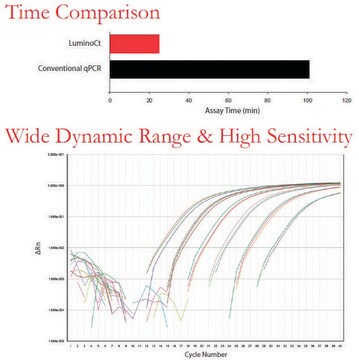FSUSGMMRO
Roche
FastStart Universal SYBR Green Master (Rox)
About This Item
Recommended Products
usage
sufficient for 200 reactions
sufficient for 2000 reactions
Quality Level
feature
dNTPs included: no
hotstart
manufacturer/tradename
Roche
packaging
pkg of 200 x 50 μL reactions (04913850001)
pkg of 2000 x 50 μL reactions (04913914001)
technique(s)
RT-qPCR: suitable
qPCR: suitable
input
purified DNA
detection method
probe-based
General description
SYBR® Green I is a DNA double-strand-specific dye. During each phase of DNA synthesis, the SYBR® Green I dye, which is included in the reaction mix, binds to the amplified PCR products. The amplicon can be detected by its fluorescence.
Hot start protocols have been shown to significantly improve the specificity, sensitivity, and yield of PCR. Heat-labile blocking groups on some of the amino acid residues of FastStart™ Taq DNA Polymerase make the modified enzyme inactive at room temperature (+15 to +25°C). Therefore, there is no elongation during the period when primers can non-specifically bind. FastStart™ Taq DNA Polymerase is activated by removing the blocking groups at a high temperature (i.e., a pre-incubation step at +95°C).
Application
Combine this master mix with Transcriptor First Strand cDNA Synthesis Kit (Roche) to achieve excellent results in two-step qRT-PCR.
FastStart™ Universal SYBR® Green Master (Rox) has been used in qRT-PCR and qPCR
Features and Benefits
- Improve PCR sensitivity and specificity.
- Avoid over-estimation of qPCR results.
- Amplify and detect a broad range of DNA or cDNA targets.
- Save time and effort in qPCR preparation.
- Prevent false positives resulting from carryover contamination.
Components
Quality
Other Notes
Legal Information
also commonly purchased with this product
Storage Class
12 - Non Combustible Liquids
wgk_germany
WGK 1
flash_point_f
does not flash
flash_point_c
does not flash
Certificates of Analysis (COA)
Search for Certificates of Analysis (COA) by entering the products Lot/Batch Number. Lot and Batch Numbers can be found on a product’s label following the words ‘Lot’ or ‘Batch’.
Already Own This Product?
Find documentation for the products that you have recently purchased in the Document Library.
Customers Also Viewed
Articles
Watch these videos to learn how real time or quantitative PCR (qPCR) works and the benefits of both the SYBR Green-based and probe-based methods of qPCR assay.
The purpose of Hot Start PCR is to inhibit the PCR reaction in order to reduce nonspecific amplification, prevent the formation of primer dimers, and increase product yields.
Related Content
Polymerase chain reaction (PCR) is a technique for amplifying nucleic acid molecules and is commonly used in many applications, including RT-PCR, hot start PCR, end point PCR and more.
RT-qPCR detects specific targets with applications in gene expression and pathogen detection.
Our team of scientists has experience in all areas of research including Life Science, Material Science, Chemical Synthesis, Chromatography, Analytical and many others.
Contact Technical Service










